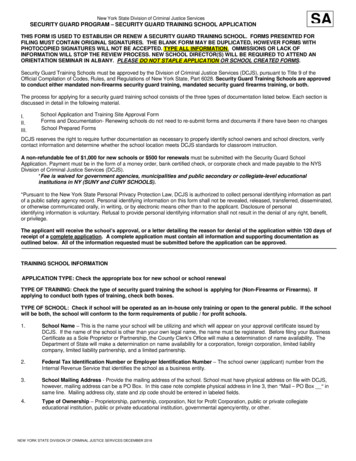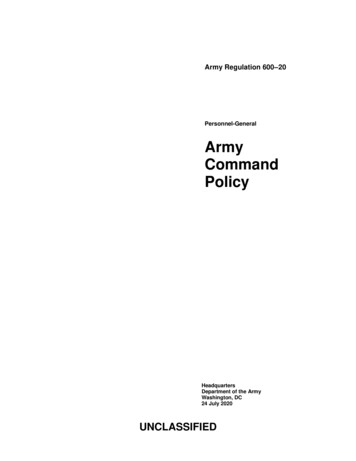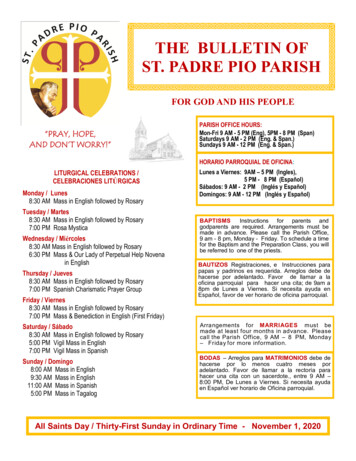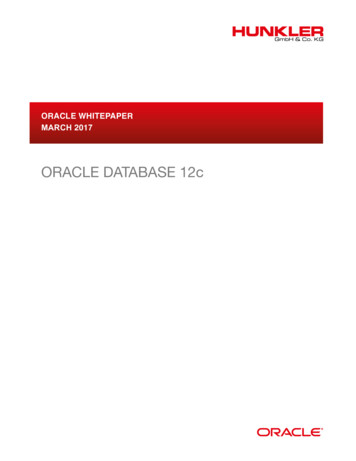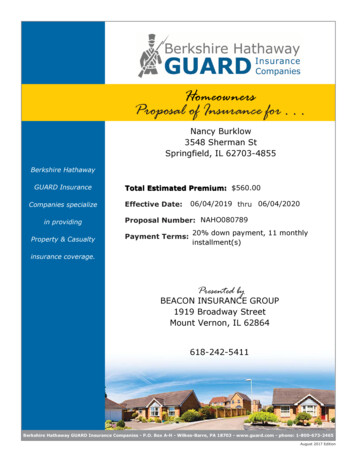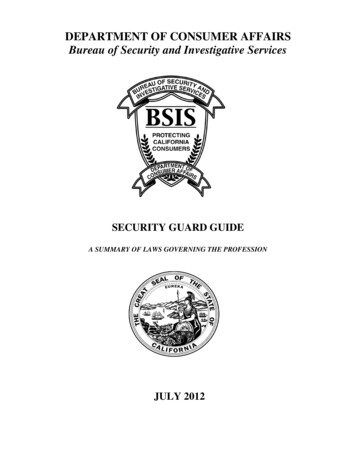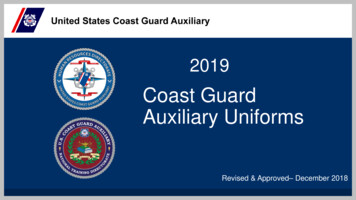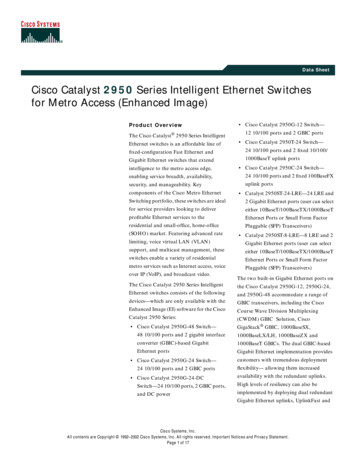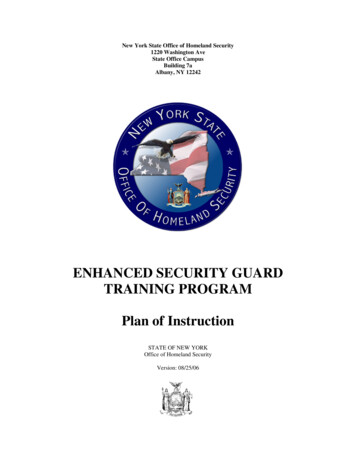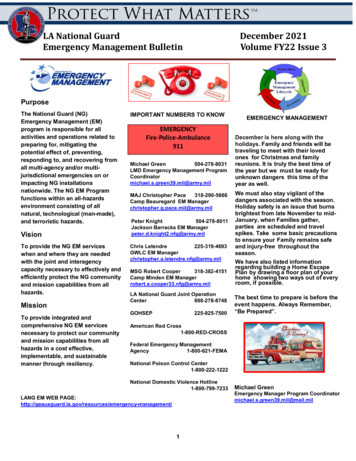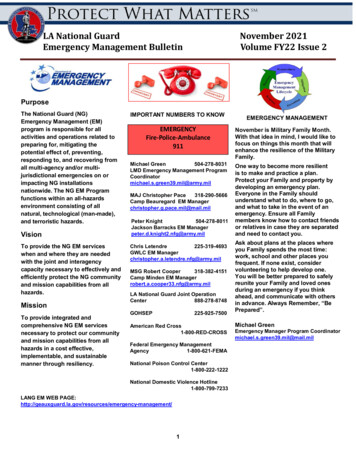
Transcription
LA National GuardEmergency Management BulletinNovember 2021Volume FY22 Issue 2PurposeThe National Guard (NG)Emergency Management (EM)program is responsible for allactivities and operations related topreparing for, mitigating thepotential effect of, preventing,responding to, and recovering fromall multi-agency and/or multijurisdictional emergencies on orimpacting NG installationsnationwide. The NG EM Programfunctions within an all-hazardsenvironment consisting of allnatural, technological (man-made),and terroristic hazards.VisionTo provide the NG EM serviceswhen and where they are neededwith the joint and interagencycapacity necessary to effectively andefficiently protect the NG communityand mission capabilities from allhazards.MissionTo provide integrated andcomprehensive NG EM servicesnecessary to protect our communityand mission capabilities from allhazards in a cost effective,implementable, and sustainablemanner through resiliency.IMPORTANT NUMBERS TO KNOWEMERGENCYFire-Police-Ambulance911Michael Green504-278-8031LMD Emergency Management J Christopher Pace318-290-5666Camp Beauregard EM Managerchristopher.g.pace.mil@mail.milPeter Knight504-278-8011Jackson Barracks EM Managerpeter.d.knight2.nfg@army.milChris Letendre225-319-4693GWLC EM Managerchristopher.a.letendre.nfg@army.milMSG Robert Cooper318-382-4151Camp Minden EM Managerrobert.a.cooper33.nfg@army.milLA National Guard Joint can Red Cross1-800-RED-CROSSFederal Emergency ManagementAgency1-800-621-FEMANational Poison Control Center1-800-222-1222National Domestic Violence Hotline1-800-799-7233LANG EM WEB management/1EMERGENCY MANAGEMENTNovember is Military Family Month.With that idea in mind, I would like tofocus on things this month that willenhance the resilience of the MilitaryFamily.One way to become more resilientis to make and practice a plan.Protect your Family and property bydeveloping an emergency plan.Everyone in the Family shouldunderstand what to do, where to go,and what to take in the event of anemergency. Ensure all Familymembers know how to contact friendsor relatives in case they are separatedand need to contact you.Ask about plans at the places whereyou Family spends the most time:work, school and other places youfrequent. If none exist, considervolunteering to help develop one.You will be better prepared to safelyreunite your Family and loved onesduring an emergency if you thinkahead, and communicate with othersin advance. Always Remember, “BePrepared”.Michael GreenEmergency Manager Program Coordinatormichael.s.green39.mil@mail.mil
LA National GuardEmergency Management BulletinNovember 2021Volume FY22 Issue 2Making a plan is simple think of the 5 W’s!Who: Creating an emergency plan is a familyactivity. Open a Family dialogue aboutpreparedness and include all members in yourpreparedness planning, Consider special needsand pets. If you require medical assistance orspecial transportation for your Family or pets,contact your local emergency manager priorto an emergency for advice.Choose a contact person living elsewhere,whom you and your Family can contact if anemergency strikes when you are separated.Keep all contact information up to date andkeep a written copy of phone numbers in yourwallet or purse.What: Plan for all hazards that can affect your Family. Consider regional weather patternsand local industrial facilities. Think through each possible emergency situation anddetermine how your Family will respond.Where: Think about all the places you and your Family may be throughout the day, suchas home, office, school, installation, and in transit. Establish plans for evacuation andmeeting places. Discuss when to employ your plans.When: Emergencies can happen anywhere, at anytime. Make your Family emergency planimmediately. Use the Family emergency plan template at this link: Family Emergency PlanReview you plan biannually and whenever there are major changes in your Family situation,schedule or activities.Why: Establish and practicing a Family emergency plan will strengthen your Family andgive you a piece of mind that you have a designated procedure. Having a plan will enableyour Family to respond to an emergency more quickly.For more information visit www.ready.gov/make-a-plan2
LA National GuardEmergency Management BulletinNovember 2021Volume FY22 Issue 2We are leaving Hurricane Season andRe-Entering Tornado Season!30 November officially ends Hurricane Season for Louisiana but November is also the second worst month forTornadoes in Louisiana.Residents of Louisiana are no strangers to the many different forms of hazardous weather. Tornadoes, damagingwinds, large hail, lightning, flooding, and even winter weather are all common weather phenomena that occur inLouisiana. When looking at statistics for the number of tornadoes, and tornado fatalities, Louisiana ranks near or atthe top in every category. These statistics show a long history of tornado impacts across the state.This presents a preparedness challenge to the residents of Louisiana. Unlike the traditional tornado alley of the GreatPlains, tornadoes are difficult to spot in Louisiana. Some of the reasons for this are poor visibility in the form ofnumerous trees in the state, the fact that many tornadoes in Louisiana are rain-wrapped, and that many Louisianatornadoes occur at night. In addition, many homes and other structures are not built as strong as buildings in otherparts of the country.All of these factors make it very important for residents of the Pelican State to have multiple ways of receivingweather warnings, have a shelter plan in place ahead of time, and take outlooks, watches and warnings seriously.These actions contribute to reducing injuries and fatalities. Situational awareness and proper planning are essentialto safety. Make your plans now for each type of hazardous weather phenomenon we encounter in Louisiana duringthe fall and winter months so you and your family will be prepared.One of the strongest tornadoes ever recorded in southeast Louisiana occurred during the early morning hours ofDec 6, 1983 when a violent (F4) tornado touched down near LaPlace. The tornado tracked 7 miles and destroyed30 houses, damaged another 125 homes and injured 25 people, 5 with serious injuries.November 21, 1997 - a strong tornado moved across St Tammany Parish, Louisiana, and continued into Pearl RiverCounty, Mississippi. Covington, Louisiana, and surrounding areas were particularly hard hit with nearly 70 homesdamaged and 4 downtown buildings damaged. 47 people suffered mainly minor injuries.November 24, 2004 - damaging straight-line winds and several tornadoes were reported during the early morninghours in an area from near Baton Rouge eastward into coastal Mississippi. A strong tornado touched near the Slidellairport damaging 152 homes in a nearby subdivision. The same storm system produced another strong tornado thattouched down around sunrise just north of Gulfport. The tornado damaged homes and businesses. Fortunately onlya few relatively minor injuries were reported. Straight-line wind damage occurred in other areas of southeastLouisiana and south Mississippi.November 15, 2006 - Severe thunderstormsproduced tornadoes as they tracked acrossareas north of Lake Pontchartrain intosouthwest Mississippi during the earlymorning hours. Several strong tornadoestouched down from east of Greensburg,Louisiana, across northern Washington Parishto east of Tylertown, Mississippi.Unfortunately, one fatality occurred nearMontpelier in St Helena Parish when astrong tornado struck a house andadjacent trailer.3
LA National GuardEmergency Management BulletinNovember 2021Volume FY22 Issue 2NOAA Weather Radio / Emergency Alert System / Wireless Emergency AlertsThe National W eather Service (NWS) utilizes NOAA Weather Radio All-Hazards to broadcast continuous weatherinformation 24 hours a day, every day of the year. This is your direct link in receiving watches and warnings from theNWS. When properly programmed, with options for single or multiple counties, the NOAA weather radio will alert you of awarning for your area, day or night. With battery back-up, the radio will still be able to deliver life-saving information even ifthe power goes out due to the storms. The state of Louisiana is served by 11 NOAA Weather Radio (NW R) transmitterswith several more surrounding transmitters in neighboring states covering additional counties.Approximately 95 percent of the people in Louisiana are within range of a NWR transmitter (see list of NWRtransmitter locations and frequencies in table below).While routine programming offers the latest forecasts, hazardous weather outlooks, current weather conditions, andofficial climate data, the broadcast cycle is automatically updated and at times interrupted whenever a specific weatherwatch, warning, or advisory is issued by an NW S Forecast Office. Watches, warnings, advisories and special weatherstatements are given the highest priority on NWR and are frequently updated with critical weather information.In an emergency, each station will transmit a warning alarm tone in addition to the SAME (Specific Area MessageEncoding) tone. Information on the emergency situation then follows. These alert tones, especially the SAME, arecapable of activating specially-designed receivers by producing a visual and/or audible alarm. For the deaf and hard ofhearing, special equipment is available to purchase for NOAA Weather Radio, such as strobe lights and bed shakers.Not all weather band receivers have this capability, but all radios that receive the NWR transmission can receive theemergency broadcasts. The warning alarms and SAME tones are tested each Wednesday, typically between 11AMand noon, weather permitting.Commercial radio and television stations, as well as cable television companies, are encouraged to use NOAA WeatherRadio in order to rebroadcast pertinent weather information to the general public. NWR is also a major part of theEmergency Alert System (EAS), which efficiently disseminates critical weather warning information through commercialbroadcast outlets in order to save your life.Wireless Emergency Alerts (WEA) are another avenue for government agencies to send urgent messages directly to cellphones in an area of interest. Applications or additional software are not needed, and the messages will look similar to textmessages when they arrive on your phone. Additional information on WEA can be found lLocations and Frequencies of NOAAWeather Radio Stations Serving LouisianaSite NameTransmitterNameCallSignFrequency PowerLakeCharlesNew OrleansBaton RougeMorgan 00New OrleansBakerMorgan CityBogalusaMonroeLake 0AlexandriaJenaWXK78 162.4751000LafayetteYoungsvilleWXK80 162.5501000WXL41 162.475WXN87 162.50010001000BurasBurasNatchitoches NatchitochesWFOLake Charles,LASlidell, LASlidell, LASlidell, LASlidell, LAShreveport, LAShreveport, LALake Charles,LALake Charles,LASlidell, LAShreveport, LA4
LA National GuardEmergency Management BulletinNovember 2021Volume FY22 Issue 2Damaging Winds: Not All Wind is a TornadoA common misconception regarding severe weather is that if there was strong wind that did damage, it must have beena tornado. Not all wind damage occurs from tornadoes. In fact, some of the worst damage is not associated withtornadoes at all. There are several types of damaging wind storms that can occur in Louisiana.Damaging wind, often also referred to as straight line winds, tends to be more common than tornadoes. Damage fromthese winds account for half of all severe reports in the continental United States. Wind speeds can reach up to 100 mphand produce a damage path extending for hundreds of miles, in association with both squall lines and supercellthunderstorms. While these winds can occur any time of the year, climatologically the number of damaging wind reportsincreases during the spring months and peaks during the summer months in Louisiana. Meteorologists can determine ifthe cause of the damage was from straight line winds or a tornado simply by looking at the direction the damage is laidout in. Straight line wind damage will push debris in the same direction the wind is blowing (hence the creation of theterm straight line). Tornado damage will scatter the debris in a variety of different directions since the winds of a tornadoare rotating violently. To reduce the damage from straight line winds, it is important to secure objects that can be blownby the wind and to keep trees well pruned. Tree branches falling on cars or houses produce a significant amount ofdamage in high wind events. Also make sure you are in a safe place when straight line winds strike such as in theinterior of a brick home.Another type of straight line wind that occurs iscalled a derecho. Derechos are created by themerging of many thunderstorm cells into a cluster,or solid line, extending for many miles. These tendto be fairly fast moving lines of thunderstorms thatmay travel 500 to 600 miles. Derechos typicallyoccur in the summer months when complexes ofthunderstorms form over the Great Plains. Theyare particularly dangerous because the damagingwinds can last a long time and cover a large area.One such event occurred in June 2012, when aderecho plowed through the Mid-South, bringing 80mph winds and structural damage to portions of theMississippi Delta.A shelf cloud over Lake Pontchartrain LA –May 30, 2011A third type of damaging wind that can occur aremicrobursts. While straight line winds tend to occurin weather systems that are widespread,microbursts are fairly localized. A microburst is asmall, concentrated downburst that produces anoutward burst of damaging winds at the surface.Microbursts are generally small (less than 4 kmacross) and short-lived, lasting only 5-10 minutes,with maximum wind speeds up to 100 mph. Thereare two kinds of microbursts: wet and dry. A wetmicroburst is accompanied by heavy precipitationat the surface, whereas dry microbursts occur withlittle or no precipitation reaching the ground.Microbursts tend to be a little more common duringthe spring and summer months in Mississippi,but can also occur in the fall and winter.Wet Microburst – 1991 Photo by William Bunting5
LA National GuardEmergency Management Bulletin6November 2021Volume FY22 Issue 2
EMERGENCY. Fir e-Po lic Ambu ance 911. Michael Green. EmergencyManager Program Coordinator. michael.s.green39.mil@mail.mil LA National Guard Joint Operation Center 888-278-8748. GOHSEP 225-925-7500. American Red Cross. 1 -800 RED CROSS. Federal Emergency Management Agency 1-800-62
